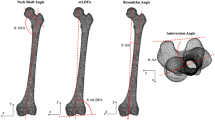Abstract
This study evaluated the development of gluteal region morphology in the female population 5 to 83 years of age. For the study, 132 female subjects were placed into four groups: prepubertal (ages 5 to 8 years; n = 10), pubertal (ages 9 to 14 years; n = 38) postpubertal (ages 15 to 41 years; n = 34), and menopausal–postmenopausal (older than 42 years; n = 29). The age, weight, and height of the subjects were routinely recorded, and body mass index was estimated. In addition, 11 measurements were performed on the gluteal region. The data were analyzed by Pearson and Spearmen correlation analyses using SSPS 11.0 for Windows. In the prepubertal group, the intergluteal sulcus and infragluteal sulci did not actively change. Weight gain was the major factor influencing the shape of the gluteal region, whereas age had no effect. In the puberty group, the gluteal region expanded in all directions. During this period, it was difficult to determine any specific relation between measurements because of significant correlation involving all parameters. However, it should be mentioned that among the four groups, only in pubertal group did age significantly affect the shape of the gluteal region. In other three groups, weight seemed to be a major determinant. In the pospubertal and menopausal–postmenopausal groups, the buttocks sagged with weight gain, contrary to the belief that this happens with aging. This causes movement of the infragluteal sulci in downward and lateral directions as well as lengthening of intergluteal sulcus.
Although the gluteal shape is open to the effects of demographic factors such as ethnicity, feeding habits, and lifestyle, according to these findings, it might be advised that in the assessment of the gluteal region morphology, it would be better to consider its dynamic nature. Reshaping its only one part, which can be devastating unless the whole gluteal region and upper limb are addressed.

Similar content being viewed by others
References
O Babuccu R Gozil S Ozmen M Bahcelioglu O Latifoglu MC Celebi (2002) ArticleTitleGluteal region morphology: The effect of the weight gain and aging Aesth Plast Surg 26 130 Occurrence Handle10.1007/s00266-001-0042-6
RE Behrman VC Vaughan WE Nelson (1987) Nelson Textbook of Pediatrics EditionNumber13 W.B. Saunders Philadelphia 20–21
AJ Hartz DC Rupley AA Rimm (1984) ArticleTitleThe association of girth measurements with disease in 32,856 women Am J Epidemiol 119 71 Occurrence Handle1:STN:280:BiuC3c7ks1I%3D Occurrence Handle6691337
D Singh (1993) ArticleTitleAdaptive significance of female physical attractiveness: Role of waist-to-hip ratio J Personality Soc Psychol 65 293 Occurrence Handle10.1037//0022-3514.65.2.293 Occurrence Handle1:STN:280:ByyA2srktVw%3D
Author information
Authors and Affiliations
Corresponding author
Rights and permissions
About this article
Cite this article
Babuccu, O., Kargı, E., Hosnuter, M. et al. Morphology of the Gluteal Region in the Female Population 5 to 83 Years of Age. Aesth Plast Surg 28, 405–411 (2004). https://doi.org/10.1007/s00266-004-4010-9
Published:
Issue Date:
DOI: https://doi.org/10.1007/s00266-004-4010-9




